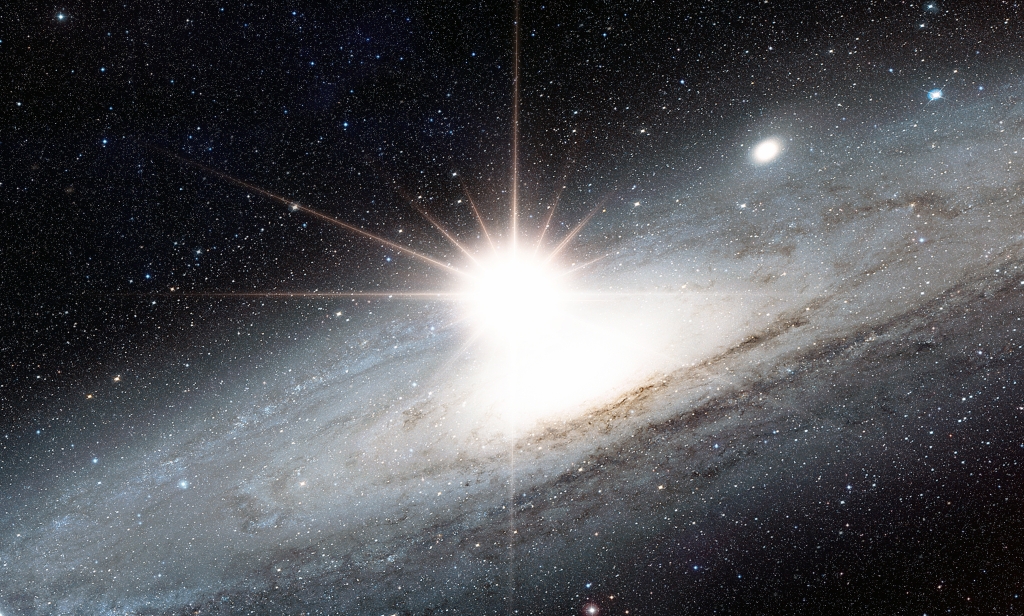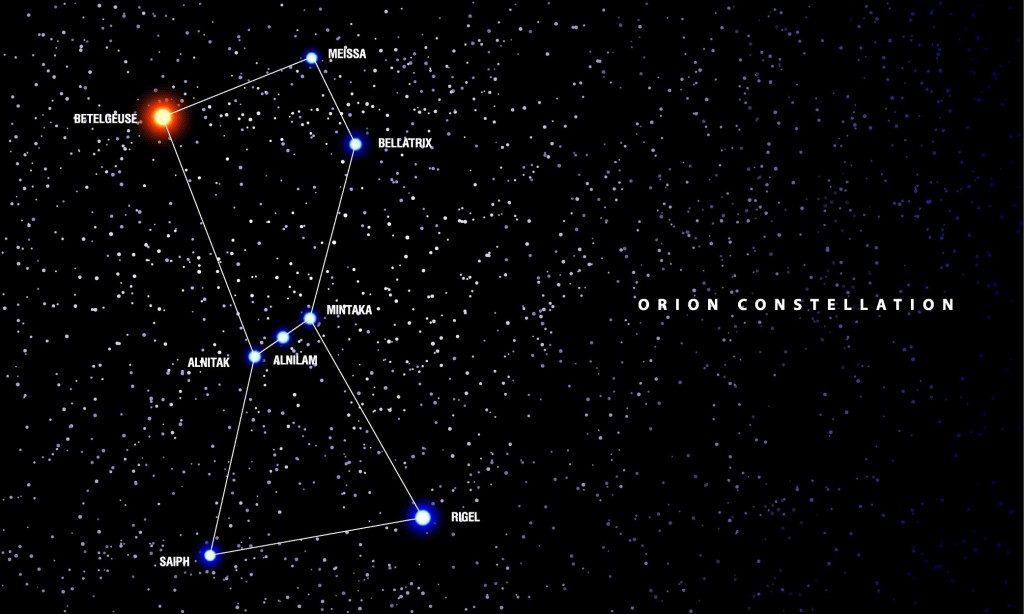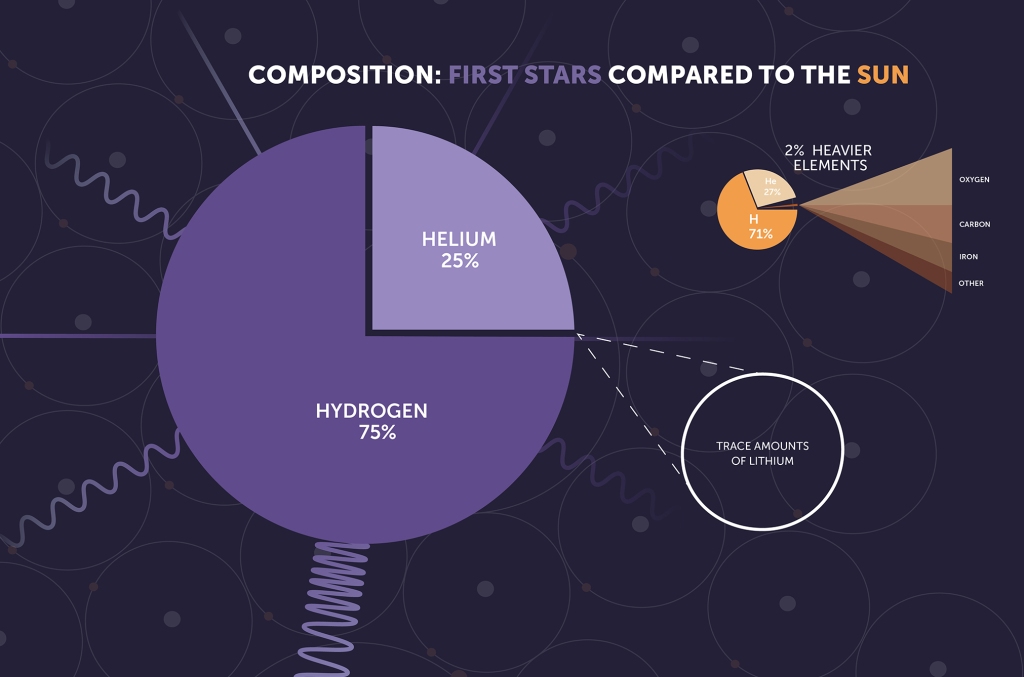This is a submission for Kevin’s No Theme Thursday

Supernova
A supernova is an explosion of a star so violent that it can outshine an entire galaxy. It can occur when a super massive star’s core contracts (the death of the star) and as it reaches a critical point it triggers nuclear reactions that cause the star to explode. Alternatively, it can occur when a white dwarf star is triggered into runaway nuclear fusion by a collision with another star.
Depending on how far away the supernova is it can be as luminous as a bright new star, the moon, or a second sun. It occurs suddenly and lasts for several weeks or months before fading away. If a supernova shines bright enough, the other stars in the sky will vanish from view. We can’t see the stars during the day, not because of the blue sky, but because of the ambient light from the sun.

The Betelgeuse Supernova
Betelgeuse the bright red star in the constellation Orion is thought to be close to going supernova, and when it does it will be about as bright as half a full moon in our sky but concentrated in a point. What does “close” mean? Some astronomers say within decades, some say within a few thousand years. Could Kevin’s beautiful picture above depict this future event?

We are stardust
The first stars in the Universe were made of 75% hydrogen and 25% helium and trace amounts of Lithium, just like the entire Universe at the time. Heavier elements that could form rocky planets or other solid celestial bodies did not exist.
However, inside the cores of these stars, heavier elements such as carbon, oxygen, and iron were formed by fusion. These early stars are referred to as first generation stars. They tended to be large and ended their lives in massive supernova explosions. The dusty remains of these explosions became the building blocks of the second and third generation stars we see today as well as the planets, our bodies and all life. We are stardust.

Finally, a 33 second YouTube video illustrating a Supernova (the creation of the Crab nebula)
Would you like to see Betelgeuse explode into a supernova in your lifetime?


This is all so fascinating! Orion is one of my fav constellations. And, definitely, I would love to see Betelgeuse exploring into a supernova! How amazing it would be?! Thanks, Thomas, for bring up one more amazing super fact! Light and blessings to you my friend!
LikeLiked by 2 people
Thank you so much Susana. I would also like to see Betelgeuse explode into a supernova. What a glorious night sky that would be. I should add I did not make this a superfact post, but it was a factual post.
LikeLiked by 1 person
I would like to see it, though it would have to happen within a couple of decades. Fascinating stuff (and beautiful), Thomas. The video was quick but mesmerizing. Thanks for the “space” fun.
LikeLiked by 1 person
Thank you so much Diane. I also think it is fascinating. It would be quite an amazing event if it happened in our lifetime. Some people might go crazy seeing it though, making up all kinds of stories instead of listening to the astro-physicists.
LikeLiked by 1 person
LOL. Yes, there are always a few who will go crazy. Hahaha.
LikeLiked by 1 person
I am wondering in these conspiracy theory laden anti-science times what some people will think when there is a new extremely bright star in the sky, about 3,800 times as bright as Sirius, or like a half moon but a point. Ignore the scientists and their stupid supernova, it is a spaceship, the aliens are coming, it is a bomb, the sky is on fire.
LikeLiked by 1 person
Or worse, Thomas. At least people don’t freak out when there’s and eclipse.
LikeLiked by 1 person
Well I am not entirely sure about that. Before/during the total eclipse in April some people (Alex Jones, even some MAGA politicians, etc.) were saying that the “elites” were planning to use the eclipse to take over the world and that there were Masonic rituals going on. That it would serve as a cover for taking down the power grid etc. But a supernova would be significantly more spectacular so it could be worse.
LikeLiked by 1 person
Oh dear. Yes, it would.
LikeLiked by 1 person
We are stardust. ✨️
LikeLiked by 1 person
Yes you are right. Thank you Sara.
LikeLike
I would imagine Thomas seeing a Supernova would be spectacular, so long as we were well away from the epicentre 🙂 or I doubt we would remember it 😉
Thank you for more Super- information, about the Cosmos Thomas…
Have A Super Weekend… ❤
LikeLike
I agree Sue, I think it would be spectacular too. Luckily Betelgeuse is sufficiently far away (650 light-years) that it poses no great risk but close enough to shine up the sky as a very bright star (~4,000 times brighter than Sirius). There is nothing closer that could turn into a supernova in the foreseeable future. Thank you so much Sue and have a super weekend you too.
LikeLiked by 1 person
That is reassuring and good to know Thomas 🙂 Have a great Super Weekend my friend xx
LikeLiked by 1 person
Well someone on Facebook pointed out to me yesterday that I only thought about myself (I posted about it on Facebook too). How about the aliens who live nearby Betelgeuse? Well, I hope there are no aliens nearby Betelgeuse. If that is the case maybe earth could accept some alien refugees. Anyway, I am not serious, but I wish you are super weekend too.
LikeLike
It’s really amazing how much power is within a star. I think we tend to take that for granted because they look so small and far away. But, it truly is awe inspiring.
Thank you for this, Thomas! Very fascinating and informative! 🙏
LikeLiked by 1 person
Thank you so much Kevin. Yes you are right. Our star, the sun, has a diameter that is 109 times larger than earth’s, which means you could fit more than a million earths inside the sun, and yet our sun is a yellow dwarf star that certainly cannot explode in a supernova. Betelgeuse on the other hand has a diameter 700 times larger than the sun’s and right now it is just a slowly glowing red ball compared to the giant explosion it one day will become. Our nuclear weapons explosions are just sardin sneezes compared to a hurricane.
LikeLiked by 1 person
When you break it down like that, it’s truly humbling
LikeLiked by 1 person
Yes you are right. When you think about it, it is humbling.
LikeLiked by 1 person
HI Thomas, this is such an interesting and enlightening post. I didn’t know about how the planets as we know them today formed. That is fascinating. Keep the posts coming.
LikeLiked by 1 person
Thank you so much for your kind words Robbie. This fascinates me too, which is why I keep posting.
LikeLike
It makes sense to research and share what interests you. There are always other people who share the interest, and it makes for good conversations.
LikeLiked by 1 person
Yes you are right Robbie, and it is great when you can have conversations about it.
LikeLike
Yes, exactly.
LikeLiked by 1 person
Thanks for the great post about the potential Betelgeuse supernova. It’s a fun topic and one near and dear to me. As I believe I mentioned, my graduate advisor, Dr. Stirling Colgate, was the astronomer who predicted that a supernova explosion would be preceded by a neutrino burst. He was proven right by Supernova 1987A. Later, some of my observations of supernovae in distant galaxies were part of the study that led to the discovery of dark energy. They’re fascinating objects. From a scientific side, it would be amazing if Betelgeuse exploded in our lifetime. It would give us an unprecedented close-up view of a supernova blast. I’m sure we’d learn a lot!
LikeLiked by 1 person
Thank you so much David for your kind support. I certainly remember you telling me about your advisor. It was nothing wrong with my advisor in Robotics but I have to admit I am a bit jeolous that you had such a prominent scientist as an advisor. His discovery/theory is extremely interesting and fascinating. I don’t seriously thing we will see a Betelgeuse supernova in our lifetime but if it happened it would be wonderful. I can only imagine the science you and your collegues would be able to figure out from it.
LikeLiked by 1 person
Lulu: “Not to be confused with a Champagne Supernova, according to our Dada!”
LikeLiked by 1 person
LOL It is great you are keeping things correct Lulu.
LikeLike
Your post is fascinating! I love the stars and moon and learning about how much deeper everything is than it actually appears is so amazing. Thank you for sharing all this enlightening information, Thomas 😊
LikeLiked by 1 person
Thank you so much for your very kind words Laura. Did you see that a couple of days ago Jupiter was really close to the full moon in the sky?
LikeLike